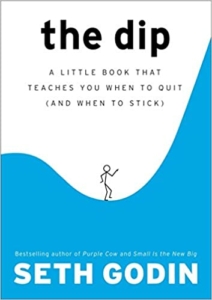Starting – and Sticking With – Blogging for Business
While launching a business blog is a fearsome thing for many, sustaining the process is even harder, as Seth Godin discusses in The Dip.
Too many business owners and professional practitioners embark on blog marketing in recognition of its power to generate interest in their products and services. What gets them down is the week-after-week work of creating new, relevant, interesting, and results-producing…blog posts.
In the face of all the compelling reports demonstrating the value of blog marketing, Caslon Analytics tells us that most blogs are abandoned soon after creation (with 60% to 80% abandoned within one month!, 1.09 million blogs were one-day wonders, with no postings on subsequent days. The average blog, Caslon remarks ruefully, “has the lifespan of a fruitfly”.
Problem is, as we well know at Say It For You, in blog marketing, it’s just not OK to quit. Those abandoned blogs belong to those who don’t recognize what Seth Godin describes as the “extraordinary benefits that accrue to the tiny minority of people who are able to push just a tiny bit longer than most”. Google and other search engines tend to give more weight to websites that update their content regularly and that “keep on keeping on.” In fact, it’s the constant, consistent stream of new content that gives blogging its edge over other forms of marketing.
After years of being involved in all aspects of corporate blog writing and corporate blogging training, one irony I’ve found is that blog content writers who do nothing more than “show up” are exceptional! That’s because business owners who are able and willing to maintain consistency and frequency in posting to their blog are so rare. Remember, a company or practice might be achieving exceptional results, but potential customers and clients don’t yet know that, and that’s the message that needs to come across in the blog (and the latest entry cannot be six months old!).
Readers and search engines each know to “expect” fresh content. Freelance blog content writers are helping their business owner and professional practitioner clients build equity in keyword phrases over time, helping clients achieve those “extraordinary benefits that accrue to the tiny minority of people who are able to push just a tiny bit longer than most”.






Follow us online!